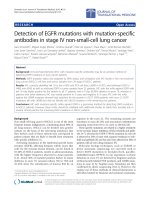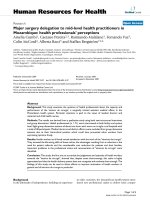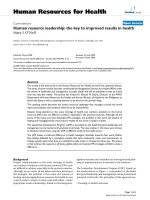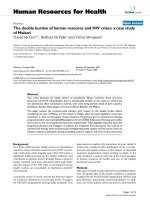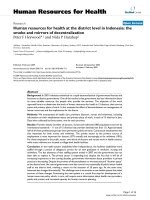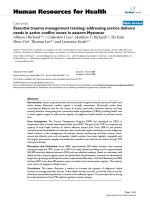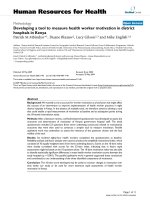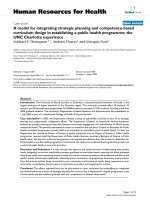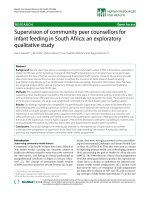Báo cáo sinh học: " Toll-like receptor 4 single-nucleotide polymorphisms Asp299Gly and Thr399Ile in head and neck squamous cell carcinomas" potx
Bạn đang xem bản rút gọn của tài liệu. Xem và tải ngay bản đầy đủ của tài liệu tại đây (873.75 KB, 9 trang )
RESEARCH Open Access
Toll-like receptor 4 single-nucleotide
polymorphisms Asp299Gly and Thr399Ile in head
and neck squamous cell carcinomas
Christoph Bergmann
1*
, Hagen S Bachmann
2
, Agnes Bankfalvi
3
, Ramin Lotfi
4
, Carolin Pütter
5
, Clarissa A Wild
1
,
Patrick J Schuler
1
, Jens Greve
1
, Thomas K Hoffmann
1
, Stephan Lang
1
, André Scherag
5
and Götz F Lehnerdt
1
Abstract
Background: Chronic inflammation plays an important role in head and neck squamous cell carcinomas (HNSCC).
This study addresses the impact of two single nucleotide polymorphisms (SNP) Asp299Gly and Thr399Ile of the
toll-like receptor (TLR) 4 gene on the clinical outcome while accounting for the influence of adjuvant systemic
therapy in a large cohort of HNSCC patients.
Methods: Genotype analysis was done using DNA from tissue samples from 188 patients with HNSCC; TLR4
protein expression was assessed immunohistochemically in tissue microarrays. Classical survival models were used
for statistical analyses.
Results: Ten percent of patients with HNSCC presented with the TLR4 299Gly and 17% with the TLR4 399Ile allele.
Patients with the heterozygous genotype TLR4 Asp299Gly had a significantly reduced disease-free and overall
survival. Also, patients with the heterozygous genotype TLR4 Thr399Ile had a reduced disease-free survival. Notably,
these associations seem to be attributable to relatively poor therapy response as e.g. reflected in a significantly
shorter DFS among HNSCC patients carrying the Asp299Gly variant and receiving adjuvant systemic therapy.
Conclusion: According to this study, TLR4 299Gly und 399Ile alleles may serve as markers for prognosis of head
and neck cancer in patients with adjuvant systemic therapy, particularly chemotherapy, and might indicate therapy
resistance.
Keywords: Toll-like receptor 4, Single-nucleotide polymorphism, HNSCC
Background
The functional relationship between inflammation and
cancer has been described since 1863, at first by
Virchow [1]. Many cancers arise from sites of chronic
inflammation, where inflammatory cells orchestrate the
tumor microenvironment fostering neoplastic processes
like proliferation, survival, and migration [2]. The upper
aero-digestive tract is chronically exposed to pathogens
and toxic irritants. For example, human papilloma virus
16 DNA can be detect ed in up to 72% of oropharyn geal
cancers [3]. Further, tobacco and alcohol consumption
is implicated in 75% of head and neck squamous cell
carcinomas (HNSCC) [4,5]. Thus, infection and inflam-
mation critically impact the development of HNSCC [6].
The family of mammalian Toll-like receptors (TLR)
consists of 11 members and is mainly expressed on
innate immune cells [7]. TLR play a pivotal role in
immune responses to exogenous pathogen-associated
(PAMPs) or t o endogenous danger-/damage-associated
molecular patterns (DAMPs). However, TLR are also
expressed on endothelial and epithelial cells, including
tumor cells [8,9]. To date, little is known about the
function and the biological importance of TLR
expressed on tumor cells. Preli minary evidence suggests
that TLR expressed on tumor cells may play an impor-
tant role in the tumor development. It has been pro-
posed that TLR-signaling mediated infection- or injury-
induced inflammation can promote tumorigenesis owing
* Correspondence:
1
Department of Otorhinolaryngology, University of Duisburg - Essen,
Hufelandstrasse 55, 45127 Essen, Germany
Full list of author information is available at the end of the article
Bergmann et al. Journal of Translational Medicine 2011, 9:139
/>© 2011 Bergmann et al; licensee BioMed Central Ltd. This is an Open Access article distributed under the terms of the Creative
Commons Attribution License ( /licenses/by/2.0), which permits unrestricted use, distribu tion, and
reproduction in any medium, provided the original work is properly cited.
to chronic tissue damage with subsequent induction o f
deregulated tissue repair [10].
TLR4 is a well characterized TLR family member,
which recogniz es PAMP s (e.g. lipopolysaccharide - LPS,
a component of gram-negative bacterial wall compo-
nent) and DAMPs (e.g. high-mobility group box 1 -
HMGB1,ahighlyconservedubiquitousproteinwith
pro-inflammatory cytokine-like properties) [11]. TLR4
expression has also been described on tumor cells of
HNSCC, where its level of expression correlates with
tumor grade. Further, TLR4 ligation on HNSCC cells
with LPS induced tumor promotion by enhancing prolif-
eration, activation of NFBandresistancetoNKcell
mediated cytotoxicity [12].
In 2001, Arbour et al. identified germ-line single-
nucleotide polymorphisms (SNPs) with co-segregating
missense mutations. These SNPs are an A/G tran sition
in exon3 causing an as partic acid/glycine substitution at
amino acid location Asp299 Gly (rs4986790), and a C/T
transition in exon4 of TLR4 causing a threonine/isoleu-
cine switch at amino acid location Thr399Ile
(rs4986791). These polymorphisms alter the amino acid
sequence of the TLR4 protein and affect the extracellu-
lar domain and ligand-recognition area of the TLR4
receptor. These SNPs have been reported to be asso-
ciated with a blunted response to inhaled LPS in
humans [13]. Importantly, Apetoh et al. reported that
patients with breast cancer, who carry at least one TLR4
loss-of-function allele, relapse more quickly after radio-
therapy and chemotherapy than those carrying two wild-
type TLR4 alleles. They also demonstrated that TLR4
Asp299Gly SNP reduces the inter acti on between TLR4
and the endogenous danger signal HMGB1. The latter
resulted in reduced capacity of dendritic cells to cross-
present melanoma c ells to Mart1-specific cytotoxic T
cells [14]. Also, both TLR4 polymorphisms are linked
with an increased susceptibility for gastric cancer and
gallbladder cancer [15,16]. In aggregate, these results
delineate a clinically relevant pathway triggered by
tumor cells with an altered TLR4 SNP.
Here, we investigate the relevance of TLR4 SNPs
Asp299Gly and Thr399Ile in 188 HNSCC patients pro-
spectively with a long follow-up (50 months) and com-
plete representative adjuvant therapy (chemotherapy and
radiation). In add ition, TLR4 expression is analyzed by
immunohistochemistry (IHC) next to TLR4 SNP geno-
type in HNSCC patients. Moreover, we investigated the
influence of adjuvant systemic therapy on prognostic
impact of TLR4.
Methods
Patients and Tissue Samples
Tissue specimens of 188 consecutive HNSCC were col-
lected by the Department of Pathology, University
hospital Essen, Germany. All patients were diagnosed
and treated at the Department of Otorhinolaryngology,
University Hospital Essen, Germany (1995-2002); treat-
ment decisions were based on consensus recommenda-
tions from oncologists, radiotherapists and head and
neck surgeons, which were based on treatment guide-
lines of treatment at the time. All patients gave written
informed consent for research use of the tissues and for
participating in the research project. The study was con-
ducted according to the Declaration of Helsinki. Tissues
were obtained during diagnostic or therapeutic surgery.
Overall, ninety nine (53%) patients received cisplatin/
5-fluorouracil-based chemotherapy regimens and radia-
tion up to 70 Gy a s adjuvant therapy after surg ery.
Seventeen (9%) patients received primary radio-che-
motherapy. Follow-up was performed regularly; median
follow-up in patients still alive at analysis was 50
months (range, 0 to 128 months). Relapse data were
available for all patients: 60 (32%) experienced disease
recurrence and 89 (47%) death. Complete therapeutic
regimens are listed in Table 1 and 2.
Table 1 Associations between TLR4 Asp299Gly SNP
genotype and clinicopathological variables
Total Asp299Asp Asp299Gly P
n (%) 138 125 (90.6) 13 (9.4)
Oro-Hypopharyngeal
SCC; n (%)
37 34 (91.9) 3 (8.1) 0.76
Laryngeal SCC; n (%) 101 90 (89.1) 11 (10.9)
Mean age ± SD [years] 61 ± 10 60 ± 10 63 ± 13 0.66
Median follow up [months]
(range)
#
50
(0-129)
52 (0-129) 42 (8-98) 0.37
Sex (male/female); n 119/19 106/19 13/0 0.21
Smoking; n (%) 124
(89.8)
112 (89.6) 12 (92.3) 1.00
Mean pack years ± SD 45 ± 25 45 ± 24.6 50 ± 29.6 0.62
Primary therapy 0.02
Surgery alone; n (%) 61 57 (45.6) 4 (30.8)
Surgery + RCT
§
; n (%) 54 51 (40.8) 3 (23.1)
Primary RCT
§
; n (%) 23 17 (13.6) 6 (46.1)
AJCC stage 0.53
I; n (%) 25 22 (17.6) 3 (23.1)
II; n (%) 33 30 (24.0) 3 (23.1)
III; n (%) 25 22 (17.6) 3 (23.1)
IVA; n (%) 50 47 (37.6) 3 (23.1)
IVB; n (%) 3 2 (1.6) 1 (7.6)
IVC; n (%) 2 2 (1.6) 0 (0.0)
Grade 0.32
1; n (%) 9 7 (5.6) 2 (15.4)
2; n (%) 96 87 (69.6) 9 (69.2)
3-4; n (%) 25 23 (18.4) 2 (15.4)
#
as based on the observed data (ignoring censoring);
§
RCT: radiation +
chemotherapy
Bergmann et al. Journal of Translational Medicine 2011, 9:139
/>Page 2 of 9
Due to poor or lack of sufficient material for PCR
or IHC or absence of complete clinicopathological
data, the initial sample of 188 patients of the total
collective was split into three groups: a group of 138
for analysis of TLR4 Asp299,agroupof62foranaly-
sis of TLR4 Thr399 (39 patients were analyzed for
both SNPs), and a group of 78 patients with HNSCC
for TLR4 expression analysis (43/78 were also geno-
typed for TLR4 Asp299; 20/78 for TLR4 Thr399 - see
Table 3).
Immunohistochemistry
Routinely formalin-fixed and paraffin-embedded tumor
tissue blocks were retrieved from the files of the Institute
of Pathology (University Hospital of Essen, Germany) and
processed using the tissue microarray (TMA) technology.
In short, tumor tissue cores of 3 mm in diameter were
removed from the area of interest from each donor block
using a hollow needl e skin biopsy punch (PFM, Cologne,
Germany) and inserted into recipient blocks in a precisely
spaced, array pattern. One tissue core of each normal thyr-
oid and kidney tissues in preset position in each block
served as control tissue and helped with the orientation.
5 μm TMA sections were cut and mounted on Super-
Frost
®
Plus slides (Menzel, Braunschweig, Germany).
IHC was performed using the Dako Autostainer Plus
System (DakoCytomation, Carpinteria, CA, USA). After
antigen retrieval (water ba th at 95°C; 20 min in citrate
buffer), TMA slides were immunostained by the T LR4
(H-80) rabbit polyclonal antibody (sc-10741, dilution
1:100, Santa Cruz Biotechnology Inc., Sant Cruz, CA,
USA). Antibody visualisation was performed using the
ant i-mo use IgG detection kit (EnVision+, DakoCytoma-
tion, Carpinteria, CA, USA) according to the manufac-
turer’s recommendations.
Evaluation of immunohistochemical staining
Stainedsectionswerereviewedbyoneoftheauthors
(AB). The percentage of tumor cells showing a positive
membranous/cytoplasmatic staining and the intensity of
staining were assessed. Cases with complete lack of
staining were scored as negative, a weak membranous/
cytoplasmic reaction in 1-50% was classified as 1+, mod-
erately strong reactions in up to 80% of tumor cells
were scored 2+, whereas moderate to strong membra-
nous/cytoplasmic immunostaining of > 80% of tumor
cells were classified as 3+ (Figure 1). Inherent positivity
of capillary endothelial cells and mononuclear inflamma-
tory cells in the stroma served as positive control; for
negative control purposes the incubation step with the
primary antibody was omitted.
Sequence analysis of TLR4
As described earlier [17], DNA samples were extracted
from 10- μm sections of formalin-fixed, paraffin-
embedded tumor tissue. The germline mutations TLR4
Asp299Gly (rs4986790) and Thr399Ile (rs4986791) were
analyzed in all pati ents using polymerase chain reaction
restriction fragment len gth polymorphism (PCR-RFLP).
Table 2 Associations between TLR4 Thr399Ile SNP
genotype and clinicopathological variables
Total Thr399Thr Thr399Ile P
n (%) 62 51 (82.3) 11 (17.7)
Laryngeal SCC; n (%) 62 51 (82.3) 11 (17.7)
Mean age ± SD [years] 60 ± 10 61 ± 10 57 ± 7 0.13
Median follow up [months]
(range)
#
52 (0-
129)
55 (0-129) 43 (9-98) 0.38
Sex (male/female); n 55/7 44/7 11/0 0.33
Smoking; n (%) 54 (87.1) 43 (84.3) 11 (100) 0.33
Mean pack years ± SD 50 ± 20.3 48.9 ± 20.3 54.1 ± 21.1 0.53
Primary therapy 0.02
Surgery alone; n (%) 34 31 (60.8) 3 (27.3)
Surgery + RCT
§
; n (%) 23 18 (35.3) 5 (45.4)
Primary RCT
§
; n (%) 5 2 (3.9) 3 (27.3)
AJCC stage < 0.01
I; n (%) 11 10 (19.6) 1 (9.1)
II; n (%) 16 14 (27.5) 2 (18.2)
III; n (%) 9 3 (5.9) 6 (54.5)
IVA; n (%) 25 23 (45.1) 2 (18.2)
IVB; n (%) 0 0 (0.0) 0 (0.0)
IVC; n (%) 1 1 (1.9) 0 (0.0)
Grade 0.86
1; n(%) 4 4 (7.8) 0 (0.0)
2; n(%) 43 34 (66.6) 9 (81.8)
3-4; n(%) 11 9 (17.6) 2 (18.2)
#
as based on the observed data (ignoring censoring);
§
RCT: radiation +
chemotherapy
Table 3 Comparison of TLR4 genotype and TLR4
expression
SNP TLR4
expression
Total wild-type
genotype
(Asp299Asp
or
Thr399Thr)
heterozygous
genotype
(Asp299Gly or
Thr399Ile)
P
TLR4
Asp299Gly
(rs4986790)
0 11 10 1 0.42
177 0
22116 5
343 1
TLR4
Thr399Ile
(rs4986791)
0 1 1 0 1.00
111 0
21512 3
333 0
Bergmann et al. Journal of Translational Medicine 2011, 9:139
/>Page 3 of 9
For rs4986790 (TLR4 8552A > G), PCR was performed
with the forward primer 5’-CTG CTC TAG AGG GCC
TGT G-3’ and the reverse primer 5’ -TTC AAT AGT
CAC ACT CAC CAG-3’, resulting in a 140 bp fragment.
After denaturation at 95°C, 38 cycles of DNA amplifica-
tion were performed using Taq DNA Polymerase 2×
Master Mix RED (Ampliqon-Biomol, Hamburg, Ger-
many ) at 95°C for 30 s, 61 °C for 30 s and 72°C for 30 s.
Digestion with BccI at 37°C (New England Biolabs Inc.,
Ipswich, MA, USA) and results in fragments of 77 bp
and 63 bp for the G-allele vs. 140 bp for the A-allele
(no digestion) separated on a 2.5% agarose gel were ana-
lysed. To genotype for rs4986791 (TLR4 8852C > T),
PCR was performed with the forward primer 5’-CTA
CCA AGC CTT GAG TTT CTA G-3’ and the reverse
primer 5’-AAG CTC AGA TCT AAA TAC CT-3’. After
denaturation at 95°C, 38 cycles of DNA amplification
were performed us ing Taq D NA Polymerase 2× Master
Mix RED (Ampliqon-Biomol, Hamburg, Germany) at
95°C for 30 s, 53°C for 30 s, and 72°C for 30 s. The
resulting 110 bp PCR products were digested using the
restriction enzyme B slI at 55°C and analyzed on a 2.5%
agarose gel. The unrestricted products represent the TT
genotype; the completely restricted products (89 and 21
bp) represent the CC genotype.
Electrophoresis was performed using SYBR Safe
®
DNA
Gel Stain (Invitrogen Corporation, Carlsbad, CA, USA) for
visualization under UV light. Correctness of genotyping
has been ensured by concomitantly analyzing DNA sam-
ples from human volunteers whose genotypes have already
been confirmed by direct sequencing. Re-genotyping of
both polymorphisms in 40 randomly chosen samples
revealed complete concordance with previous results.
While the TLR4 Asp299Gly genotype was evaluable in
138 patients, the TLR4 Thr399Ilegenotypewasonly
evaluable in 62 patients. This was d ue to a low amount
of and strongly degraded DNA i n the available paraffin-
embedded tumor tissue probably because of unbuffered
paraffin on the tumor cells in more than 10 years old
paraffin-embedded tissue samples or a high guanine-
cytosine content in the gene region for Thr399, which
hampers amplification. Therefore every sample was
tested four times but utilizable DNA-products were
availableonlyforthose62patients.Duetothereduced
quality of samples other methods for genotyping (e.g.
direct sequencing, pyrosequencing or TaqMan-genotyp-
ing) were not considered.
Statistical Analysis
The two genotype distributions were tested for devia-
tions from Hardy Weinberg equilibrium (both two-sided
exact p-values were 1.0). Associations between clinical
tumor characteristics and TLR4 genotype were assessed
either by non-parametric Wilcoxon-Mann-Whitney tests
in case of quantitative variables or b y generalized Fish-
er’s exact test for categorical variables in 2 × m tables.
Time to events was calcul ated as the difference between
primary diagnosis and either the date of the clinical
assessment where the respective event occurred or last
clinical assessment in case of censoring. While surviv al
probabilities were graphically assessed b y the Kaplan
Meier method (including a log-rank test for inference in
the figures), uni- and multiple cox regression analyses
were used for the statistical analyses. In the multiple
regression model variables with p > .1 in the univariate
model were excluded to address estimation concerns.
Model diagnostic of t he proportional hazards (PH)
assumption for the TLR4 genotypes comprised both gra-
phical and formal investigations - none of which indi-
cated strong evidence for a deviation from the PH
assumption. Confidence intervals were calculated with
cov erage of 95% level (95%CI) and accor dingly the level
a for each test was 0.05 (two-sided). Unless otherwise
mentioned, all reported p-values are nominal and two-
sided.
Results
Distribution of TLR4 Asp299Gly and Thr399Ile
In the present primary HNSCC cohort, 125 patients
(90.6%) showed a homozygous TLR4 genotype for aspar-
tate at aminoac id location 299, and 13 patients (9.4%)
had a TLR4 Asp299Gly variant (minor allele frequency
(MAF) ~4.7%). We observed no evidence for a deviation
from Hardy-Weinberg equilibrium (HWE; p = 1.0; two-
sided exact test). The genotype distribution is in accor-
dance with previous reports [13,15], which describe a
carrier frequency of ~7% in both healthy controls and
Figure 1 TLR4 immunohistochemistry in hea d and neck
squamous cell carcinomas. (A) Strong (score 3+); (B) moderate
(score 2+); (C) weak staining (score 1+); (D) negative control (no
immunoreactivity); (E) positive control (strong staining in endothelial
inflammatory cells expressing TLR4).
Bergmann et al. Journal of Translational Medicine 2011, 9:139
/>Page 4 of 9
gastric cancer patients of the Caucasian population.
Regarding the other SNP (Thr399Ile) 51 out of 62
(82.3%) of our patients we re homozygous for threonine
and 11 heterozygous (17.7%) for threonin e and isoleu-
cine alleles (MAF ~ 8.9%; p = 1.0; two-sided exact test
for deviations from HWE).
No evidence for associations was fo und between clini-
cal tumor characteristics or histopathological character-
istics and TLR4 Asp299Gly genotype (Table 1). For th e
TLR4 Thr399Thr genotype the explorative statistical
analysis indicated a positive correla tion between AJCC
tumor stage and Thr399Thr genotype only (p < 0.01;
Table 2).
Expression patterns of TLR4
Sixteen percent of HNSCC tumors showed low (score 1
+), 49% moderate (2+), 9% strong (3+), and 26% showed
no TLR4 staining (Figure 1; Table 3). TLR4 staining (all
scores) showed a diffuse and fine granular cytoplasmatic
pattern. Distinct membrane staining was observed in
some tumors but n ever without cytoplasmatic staining.
TLR4 scores did not significantly correlate with clinico-
pathologic variables, in particular there was no correla-
tion between TLR4 expression patterns and disease-free
or overall survival (data not shown).
TLR4 Genotype and Expression of TLR4
TLR4 genotype showed no evidence for an association
with TLR4 protein expression phenotype (IHC; Table
3). Altered grouping of the expression values (low/high
forgrade0/1or2/3)orTLR4 genotype (wild-type for
both SNPs vs. a ny heterozygous variant) had n o impact
on this observation.
TLR4 Genotype and Disease Advancement
Our analysis revealed a significant association between
TLR4 Asp299Gly genotype and recurrence of disease
with a hazard ratio (hr) of 2.37 for a reduced disease-
free survival (DFS; 95%CI: 1.05-5.33; p = 0.04; Figure
2A). Also, overall survival (OS) was significantly asso-
ciated with Asp299Gly genotype with a hazard ratio of
2.00 for reduced survival (OS; 95%CI: 1.02-3.92; p =
0.04; Figure 2B; Table 4).
For the other SNP a similar pattern was observable
(Figure 3); in case of DFS patients with the Thr399Ile
variant displayed a significantly higher risk for disease
advancement (hr = 4.97; 95%CI: 2.00-12.37; p = 0.0006;
Figure 3B).
TLR4 Genotype in a Multivariable Cox Regression Model
Next, we considered clinicopathological variables (a ge,
sex, smoking, AJCC stage) in univariate cox models for
overall survival. Afterwards we jointly included clinico-
pathological variables in addition to TLR4 Asp299Gly
genotype status in a multivariable cox mod el (Table 4).
Though a similar result pattern was observed for the
TLR4 Thr399Ile variant, we decided to limit the dis-
played analyses to TLR4 Asp299Gly due to the too
small sample s ize for the Thr399Ile variant. Even after
correcting for clinicopathological variables TLR4
Asp299Gly genotype status was an independent prog-
nostic factor of overall survival with a hazard ratio of
2.02 for reduced survival (95%CI: 1.01-4.06; p = 0.05;
Table 4).
TLR4 Asp299 Genotype and Adjuvant Systemic Therapy
Based on the observed correlation of TLR4 genotype
andappliedprimarytherapy(Table1and2),wealso
explored the additional impact of the use of adjuvant
systemic therapy in the survival analysis (as main and
interaction effect with TLR4 Asp299 genotype in the
multivariate model of Table 4). According to this analy-
sis, the interaction term indicated no evidence for an
interaction (p = 0.18) which most likely reflects that the
sample was statistically underpowered to detect an
interaction. Displaying the relationship between TLR4
Figure 2 TLR4 Arg299 allele impact on survival and tumor recurre nce. Probability of (A) overall survival (OS) and (B) disease-free survival
(DFS) in patients according to TLR4 allele status (TLR4 Asp299Asp vs. TLR4 Asp299Gly). P-values obtained from the log-rank test are indicated.
Bergmann et al. Journal of Translational Medicine 2011, 9:139
/>Page 5 of 9
Asp299Gly genotype, use of adjuvant systemic therapy
and course of disease graphically, we observed no evi-
dence for significant survival differen ces between TLR4
genotypes in patients without adjuvant systemic therapy.
However, with adjuvant systemic therapy, patients with
wild-type genotype showed significantly longer DFS (p =
0.004 by log-rank test; Figure 4).
Discussion
TLR4 signalin g is strongly invol ved in inflammatory pro-
cesses. HNSCC is a cancer entity which is known to
develop from chronic inflammation [6]. Consequently,
inflamma tion-related signaling pathways are involved the
tumor and the host cells. Here, we demonstrate that TLR4
is upregulated in tumors from HNSCC patients, which is
in accordance with published data [12]. The SNPs Asp299
and Thr399 have been reported to be involved in inflam-
mation, atherogenesis, sepsis and cancer [13-15,18-21]. In
this study, we provide evidence in a sample of 188 patients
that these SNPs are involved in the tumor development of
HNSCC with a significant impact on tumor advancement
and survival of patients. Further, we demonstrate that the
clinical impact of the SNP genotype is stronger if adjuvant
systemic therapy is administered.
No significant associations were found between TLR4
expression status and established clinicopathological
Table 4 Uni- and multivariate cox model for overall survival including clinicopathological variables and TLR4
Asp299Gly SNP genotype - hazard ratio point estimates, 95% CIs and p-values (2-sided) from Wald-tests are reported
Univariate
cox model
Multivariate
cox model*
hazard ratio [95% CI] P hazard ratio
[95% CI]
P
TLR4 Asp299Gly genotype
Asp299Asp 1 - 1 -
Asp299Gly 2.00 [1.02 3.92] 0.04 2.02 [1.01 4.06] 0.05
Age
[per 5 years] 1.11 [0.98 1.25] 0.10
Sex
female 1 - 1 -
male 2.55 [1.03 6.36] 0.04 2.91 [1.15 7.32] 0.02
Smoking
#
no 1 -
yes 0.91
[0.42 2.00]
0.82
AJCC stage
I1-1-
II 1.86 [0.70 4.97] 0.21 1.87 [0.70 5.00] 0.21
III 2.40 [0.89 6.50] 0.08 2.25 [0.83 6.11] 0.11
IV
§
4.08 [1.72 9.66] 1.1 × 10
-3
4.66 [1.96 11.09] 5.0 × 10
-4
#
using ‘Mean pack years’ instead had no imp act on the findings;
§
which summarizes stages IVA, IVB and IVC
Figure 3 TLR4 Thr399 allele impact on survival and tumor recurrence. Probability of (A) overall survival (OS) and (B) disease-free survival
(DFS) in patients according to TLR4 allele status (TLR4 Thr399Thr vs. TLR4 Thr399Ileu). P-values from the log-rank test are indicated.
Bergmann et al. Journal of Translational Medicine 2011, 9:139
/>Page 6 of 9
variables, in contrast to observations by Szczepanksi et
al, who described a correlation of TLR4 expression
intensity and tumor grade in a cohort of 39 HNSCC
patients [12]. This group further demonstrated a TLR4-
mediated protective effect for HNSCC cells from cispla-
tin-induced apoptosis by in vitro studies.
TLR4 alleles Asp299 and Thr399 may also be in link-
age disequilibrium with other genetic changes that con-
tribute to poor prognosis in HNSCC [22]. Yet, cancer
cells ectopically expressing TLR4 do possess increased
cell motility and invasiveness, both characteristic of an
aggressive tumor phenotype [12]. We report a reduced
disease-free survival and overall survival for TLR4 loss-
of-function carriers in HNSCC patients. This is in line
with a recently published study which gained similar
results in an analysis of patients with colon cancer [23].
We show that late stage tumor progression may be
genetically linked to the TLR4 Thr399Ile genotype,
which is in contrast to observations of Pandey et al.,
who reported a significant association of this genotype
with cervical cancer at an early stage [24].
The impact of conventional anticancer chemother-
apy not only affects the tumor but also modulates the
relationship between the tumor and the immune sys-
tem. Recent insights are providing evidence for this
new concept of cancer therapy and immunotherapy
which is rapidly emerging. Chemotherapy can stimu-
late the immune system, either via a direct effect on
immune effectors or regulatory mechanisms or indir-
ectly, by causing lymphopenia followed by homeo-
static proliferation of immune effectors that may be
particularly active in the anticancer response. Interac-
tion of TLR4 binding partners, which have been
secreted by tumor cells (so-called danger signals, e.g.
HMGB1) activate leukocytes through the differential
engageme nt of multiple surface receptors like TLR4
and RAGE [25]. Further, it has been demonstrated
that the TLR4 Asp299 polymorphism affects the bind-
ing of HMGB1 to TLR4 and predicts early relapse
after chemotherapy in breast cancer patients. In parti-
cular, the TLR4 mutation has been identified as an
independent predictive factor for the success of
anthracycline-based adjuvant regimen’[14]. Apetoh et
al. further demonstrated that HMGB1 released from
oxaliplatin-treated dying tumor cells binds to TLR4
on dendritic cells and is required for cross-presenta-
tion of tumor antigens and a subsequent effective
anti-tumor immune response. This effect was
impaired in HeLa cells transfected with a cDNA
encoding the Asp299Gly allele of TLR4 and resulted
in impaired nuclear factor-B activation a fter stimula-
tion with recombinant HMGB1 [26,27].
It is also believed that optimal therapeutic effects
require the immunoadjuvant effect of DAMPs like
HMGB1 released from tumor cells damaged by cyto-
toxic anticancer agents. In other words, anticancer
immune responses may contribute to the control of can-
cer after conventional chemotherapy. Thus, radiotherapy
and some chemotherapeutic agents can induce specific
immune responses that result either in immunogenic
cancer cell death or in immunostimulatory side effects
[28]. Very recently, Tesniere et al. demonstrated that
Cisplatin was efficient in triggering HMGB1 release in
colon cancer cells [23]. Another effect has been demon-
strated for the use of anti-tumor cytotoxic agents, like
oxaliplatin and 5-fluorouracil which at least partially
deplete or transiently inactivate tumor-protective regula-
tory T cells (Treg) [29,30] as we have recently reported
a significantly increased expression of TLR on Treg in
patients with HNSCC [31]. Consequently, a decreased
interaction of tumor-derived HMGB1 with TLR4-
expressing Treg might result in a decre ased anti-tumor
immune response in TLR4 Asp299Gly or Thr399Ile car-
riers which may result in a reduced DFS and OS.
Figure 4 TLR4 Arg299 allele impact on tumor recurrence stratified by adjuvant systemic therapy. (A) no systemic therapy and (B)
adjuvant systemic therapy; in patients according to TLR4 allele status (TLR4 Asp299Asp vs. TLR4 Asp299Gly). P-values from the log-rank test are
indicated. DFS: disease-free survival.
Bergmann et al. Journal of Translational Medicine 2011, 9:139
/>Page 7 of 9
Conclusion
Our study provides evidence for an established concept
of altered chemosensitivity of tumor cells to chemother-
apeutic drugs in regards to their respective polymorphic
genotype [32] as w e demonstrate that patients wit h
TLR4 Asp299 wild-type genotype showed significantly
better DFS with adjuvant systemic therapy including
agents like cisplatin and 5-fluoruracil. Several studies
have reported that SNP genotypes are highly associated
with altered drug response and impact on survival (i.e.
soft-tissue sarcoma [33] and colorectal cancer [34]. Ulti-
mately, consideration of therapeutically relevant SNP
might contribute to improved therapies and patients’
survival. However, our study has clear limitations due to
the small sample size. Therefore, clinical applicability of
this biomarker information requires the inclusion of
genotype information in prospectively planned rando-
mizedcontrolledtrials(RCTs)ofpropersamplesizein
various populations.
In summary, our data suggests that polymorphisms
TLR4 Asp299Gly and TLR4 Thr399Ile are involved in
the advancement of HNSCC. Moreover, TLR4 genotype
seems to have an impact on the success of antitumor
therapy. Since TLR, and in particular TLR4, are in focus
of molecular cancer therapy development [35], such
results might open the door to set up prospectively
planned RCTs that include TLR4 genotype information
while evaluating new and advanced treatments of
HNSCC. In the end, our observations may result in ben-
efit for the patient when clinically exploited to enhance
the efficiency and immunogenicity of current che-
motherapeutic regimens as well as overcoming the
immune defect induced by deficient TLR4 signaling b y
combining chemotherapy with alternate TLR4 agonists.
Abbreviations
(HNSCC): Head and neck squamous cell carcinomas; (TLR): Toll-like receptors;
(PAMPs): pathogen-associated molecular patterns; (DAMPs): danger-/
damage-associated molecular patterns; (LPS): lipopolysaccharide; (HMGB1):
high-mobility group box 1; (SNP): single-nucleotide polymorphism; (IHC):
immunohistochemistry; (TMA): tissue microarray; (PCR-RFLP): polymerase
chain reaction restriction fragment length polymorphism; (PH): proportional
hazards; (HWE): Hardy-Weinberg equilibrium; (MAF): minor allele frequency;
(AJCC): American Joint Committee of Cancer; (DFS): Disease-free survival;
(OS): Overall Survival; (RAGE): receptor of advanced glycation endproducts;
(RCT): Radio-Chemo-Therapy
Acknowledgements
We thank Stephanie Büscher for her excellent technical assistance.
Funding
Research described in this article was supported in part by Deutsche
Forschungsgemeinschaft (DFG 4190/1-1 to CB) and in part by Stiftung HNO
UK Essen (to CB and GFL)
Author details
1
Department of Otorhinolaryngology, University of Duisburg - Essen,
Hufelandstrasse 55, 45127 Essen, Germany.
2
Department of
Pharmacogenetics, University of Duisburg - Essen, Hufelandstrasse 55, 45127
Essen, Germany.
3
Department of Pathology, University of Duisburg - Essen,
Hufelandstrasse 55, 45127 Essen, Germany.
4
Institute for Transfusion
Medicine, University of Ulm, Helmholtzstr. 10, 89081 Ulm, Germany.
5
Institute
for Medical Informatics, Biometry and Epidemiology, University of Duisburg -
Essen, Hufelandstrasse 55, 45122 Essen, Germany.
Authors’ contributions
CB designed the study and participated in data analysis and interpretation.
AB, TKH, SL, RL and GL provided study materials or patients. HSB, PS, JG, AB,
CW and GL participated in collection and assembly of data. CP and AS
participated in data analysis and interpretation. CB, HSB, AB and AS wrote
the manuscript. All authors read and approved the final manuscript
Competing interests
The authors declare that they have no competing interests.
Received: 29 May 2011 Accepted: 21 August 2011
Published: 21 August 2011
References
1. Balkwill F, Mantovani A: Inflammation and cancer: back to Virchow?
Lancet 2001, 357:539-545.
2. Coussens LM, Werb Z: Inflammation and cancer. Nature 2002, 420:860-867.
3. D’Souza G, Kreimer AR, Viscidi R, Pawlita M, Fakhry C, Koch WM, Westra WH,
Gillison ML: Case-control study of human papillomavirus and
oropharyngeal cancer. N Engl J Med 2007, 356:1944-1956.
4. Hilgert E, Bergmann C, Fichtner A, Gires O, Issing W: Tobacco abuse relates
to significantly reduced survival of patients with oropharyngeal
carcinomas. Eur J Cancer Prev 2009, 18:120-126.
5. Vineis P, Alavanja M, Buffler P, Fontham E, Franceschi S, Gao YT, Gupta PC,
Hackshaw A, Matos E, Samet J, Sitas F, Smith J, Stayner L, Straif K, Thun MJ,
Wichmann HE, Wu AH, Zaridze D, Peto R, Doll R: Tobacco and cancer:
recent epidemiological evidence. J Natl Cancer Inst 2004, 96:99-106.
6. Argiris A, Karamouzis MV, Raben D, Ferris RL: Head and neck cancer. Lancet
2008, 371:1695-1709.
7. Akira S, Uematsu S, Takeuchi O: Pathogen recognition and innate
immunity. Cell 2006, 124:783-801.
8. Dauphinee SM, Karsan A: Lipopolysaccharide signaling in endothelial
cells. Lab Invest 2006, 86:9-22.
9. Chen R, Alvero AB, Silasi DA, Steffensen KD, Mor G: Cancers take their Toll–
the function and regulation of Toll-like receptors in cancer cells.
Oncogene 2008, 27:225-233.
10. Rakoff-Nahoum S, Medzhitov R: Toll-like receptors and cancer. Nat Rev
Cancer 2009, 9:57-63.
11. Lotze MT, Tracey KJ: High-mobility group box 1 protein (HMGB1): nuclear
weapon in the immune arsenal. Nat Rev Immunol 2005, 5:331-342.
12. Szczepanski MJ, Czystowska M, Szajnik M, Harasymczuk M, Boyiadzis M,
Kruk-Zagajewska A, Szyfter W, Zeromski J, Whiteside TL: Triggering of Toll-
like receptor 4 expressed on human head and neck squamous cell
carcinoma promotes tumor development and protects the tumor from
immune attack. Cancer Res 2009, 69:3105-3113.
13. Arbour NC, Lorenz E, Schutte BC, Zabner J, Kline JN, Jones M, Frees K,
Watt JL, Schwartz DA: TLR4 mutations are associated with endotoxin
hyporesponsiveness in humans. Nat Genet 2000, 25:187-191.
14. Apetoh L, Ghiringhelli F, Tesniere A, Obeid M, Ortiz C, Criollo A, Mignot G,
Maiuri MC, Ullrich E, Saulnier P, Yang H, Amigorena S, Ryffel B, Barrat FJ,
Saftig P, Levi F, Lidereau R, Nogues C, Mira JP, Chompret A, Joulin V, Clavel-
Chapelon F, Bourhis J, Andre F, Delaloge S, Tursz T, Kroemer G, Zitvogel L:
Toll-like receptor 4-dependent contribution of the immune system to
anticancer chemotherapy and radiotherapy. Nat Med 2007, 13
:1050-1059.
15.
Santini D, Angeletti S, Ruzzo A, Dicuonzo G, Galluzzo S, Vincenzi B,
Calvieri A, Pizzagalli F, Graziano N, Ferraro E, Lorino G, Altomare A,
Magnani M, Graziano F, Tonini G: Toll-like receptor 4 Asp299Gly and
Thr399Ile polymorphisms in gastric cancer of intestinal and diffuse
histotypes. Clin Exp Immunol 2008, 154:360-364.
16. Kutikhin AG: Impact of Toll-like receptor 4 polymorphisms on risk of
cancer. Hum Immunol 2011, 72:193-206.
17. Lehnerdt GF, Franz P, Zaqoul A, Schmitz KJ, Grehl S, Lang S, Schmid KW,
Siffert W, Jahnke K, Frey UH: Overall and relapse-free survival in
oropharyngeal and hypopharyngeal squamous cell carcinoma are
associated with genotypes of T393C polymorphism of the GNAS1 gene.
Clin Cancer Res 2008, 14:1753-1758.
Bergmann et al. Journal of Translational Medicine 2011, 9:139
/>Page 8 of 9
18. Lorenz E, Patel DD, Hartung T, Schwartz DA: Toll-like receptor 4 (TLR4)-
deficient murine macrophage cell line as an in vitro assay system to
show TLR4-independent signaling of Bacteroides fragilis
lipopolysaccharide. Infect Immun 2002, 70:4892-4896.
19. Kiechl S, Lorenz E, Reindl M, Wiedermann CJ, Oberhollenzer F, Bonora E,
Willeit J, Schwartz DA: Toll-like receptor 4 polymorphisms and
atherogenesis. N Engl J Med 2002, 347:185-192.
20. Lorenz E, Mira JP, Frees KL, Schwartz DA: Relevance of mutations in the
TLR4 receptor in patients with gram-negative septic shock. Arch Intern
Med 2002, 162:1028-1032.
21. Hold GL, Rabkin CS, Chow WH, Smith MG, Gammon MD, Risch HA,
Vaughan TL, McColl KE, Lissowska J, Zatonski W, Schoenberg JB, Blot WJ,
Mowat NA, Fraumeni JF Jr, El-Omar EM: A functional polymorphism of
toll-like receptor 4 gene increases risk of gastric carcinoma and its
precursors. Gastroenterology 2007, 132:905-912.
22. Ferwerda B, McCall MB, Verheijen K, Kullberg BJ, van der Ven AJ, Van der
Meer JW, Netea MG: Functional consequences of toll-like receptor 4
polymorphisms. Mol Med 2008, 14:346-352.
23. Tesniere A, Abermil N, Schlemmer F, Casares N, Kepp O, Pequignot M,
Michaud M, Martins I, Senovilla L, Zitvogel L, Kroemer G: In vivo depletion
of T lymphocyte-specific transcription factors by RNA interference. Cell
Cycle 2010, 9:2830-2835.
24. Pandey S, Mittal RD, Srivastava M, Srivastava K, Singh S, Srivastava S,
Mittal B: Impact of Toll-like receptors [TLR] 2 (-196 to -174 del) and TLR 4
(Asp299Gly, Thr399Ile) in cervical cancer susceptibility in North Indian
women. Gynecol Oncol 2009, 114:501-505.
25. Sims GP, Rowe DC, Rietdijk ST, Herbst R, Coyle AJ: HMGB1 and RAGE in
inflammation and cancer. Annu Rev Immunol 2010, 28:367-388.
26. Apetoh L, Ghiringhelli F, Tesniere A, Criollo A, Ortiz C, Lidereau R,
Mariette C, Chaput N, Mira JP, Delaloge S, Andre F, Tursz T, Kroemer G,
Zitvogel L: The interaction between HMGB1 and TLR4 dictates the
outcome of anticancer chemotherapy and radiotherapy. Immunol Rev
2007, 220:47-59.
27. Apetoh L, Tesniere A, Ghiringhelli F, Kroemer G, Zitvogel L: Molecular
interactions between dying tumor cells and the innate immune system
determine the efficacy of conventional anticancer therapies. Cancer Res
2008, 68:4026-4030.
28. Zitvogel L, Apetoh L, Ghiringhelli F, Andre F, Tesniere A, Kroemer G: The
anticancer immune response: indispensable for therapeutic success? J
Clin Invest 2008, 118:1991-2001.
29. Ghiringhelli F, Larmonier N, Schmitt E, Parcellier A, Cathelin D, Garrido C,
Chauffert B, Solary E, Bonnotte B, Martin F: CD4+CD25+ regulatory T cells
suppress tumor immunity but are sensitive to cyclophosphamide which
allows immunotherapy of established tumors to be curative. Eur J
Immunol 2004, 34:336-344.
30. Lutsiak ME, Semnani RT, De Pascalis R, Kashmiri SV, Schlom J, Sabzevari H:
Inhibition of CD4(+)25+ T regulatory cell function implicated in
enhanced immune response by low-dose cyclophosphamide. Blood
2005, 105:2862-2868.
31. Wild C, Brandau S, Lindemann M, Lotfi R, Hofmann TK, Lang S, Bergmann C:
Toll-like receptors in regulatory T cells of patients with head and neck
cancer. Arch Otolaryngol Head Neck Surg 2010, 136:1253-1259.
32. Auman JT, McLeod HL: Cancer pharmacogenomics: DNA genotyping and
gene expression profiling to identify molecular determinants of
chemosensitivity. Drug Metab Rev 2008, 40:303-315.
33. Vazquez A, Grochola LF, Bond EE, Levine AJ, Taubert H, Muller TH, Wurl P,
Bond GL: Chemosensitivity profiles identify polymorphisms in the p53
network genes 14-3-3 tau and CD44 that affect sarcoma incidence and
survival. Cancer Res 2010, 70:172-180.
34. Kim JC, Kim SY, Cho DH, Ha YJ, Choi EY, Kim CW, Roh SA, Kim TW, Ju H,
Kim YS: Novel chemosensitive single-nucleotide polymorphism markers
to targeted regimens in metastatic colorectal cancer. Clin Cancer Res
2011, 17:1200-1209.
35. Hennessy EJ, Parker AE, O’Neill LA: Targeting Toll-like receptors: emerging
therapeutics? Nat Rev Drug Discov 9:293-307.
doi:10.1186/1479-5876-9-139
Cite this article as: Bergmann et al.: Toll-like receptor 4 single-
nucleotide polymorphisms Asp299Gly and Thr399Ile in head and neck
squamous cell carcinomas. Journal of Translational Medicine 2011 9:139.
Submit your next manuscript to BioMed Central
and take full advantage of:
• Convenient online submission
• Thorough peer review
• No space constraints or color figure charges
• Immediate publication on acceptance
• Inclusion in PubMed, CAS, Scopus and Google Scholar
• Research which is freely available for redistribution
Submit your manuscript at
www.biomedcentral.com/submit
Bergmann et al. Journal of Translational Medicine 2011, 9:139
/>Page 9 of 9
